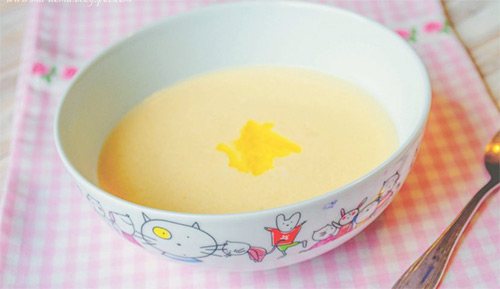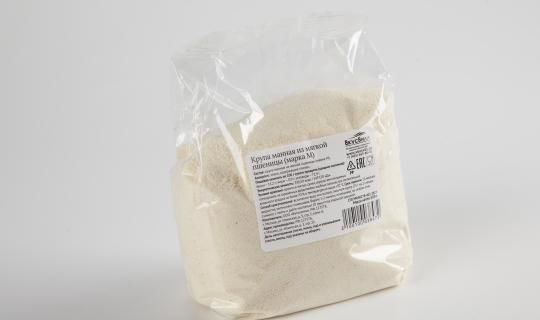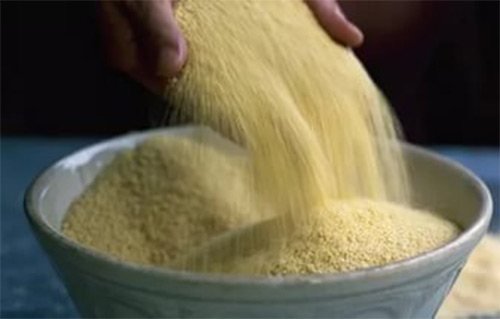Surely the taste of semolina porridge is familiar to everyone from childhood. This product is made from certain varieties of wheat, the grains of which are cut very finely. But when choosing, you should read the label. So, for example, the letter “M” will indicate that soft wheat was used in production. You can also distinguish by color; semolina in this category is white. Category “T” is made from hard varieties and has a yellowish tint. "M" is a mixture.
As a rule, the “M” category is best for casseroles and baked goods, “T” for puddings and pancakes, and “MT” for everything.
In general, semolina porridge is a simple and satisfying dish that is very easy to prepare. For 1 liter of milk you need about 3-4 tablespoons of semolina, or 2 tablespoons if you don’t like thick porridge. Semolina contains many useful vitamins and minerals: most of all vitamin E (2.55 mg per 100 g), PP, B1, B6, B9, as well as iron (1 mg), zinc, copper, chromium, fluorine and silicon.
Semolina, is it possible or not?
While breastfeeding, mothers have many questions regarding their diet. After all, healthy and completely harmless products that the mother preferred before the birth of the child can negatively affect the baby’s health.
Therefore, the question often arises why mothers are not allowed semolina porridge while breastfeeding. This cereal has been known to us since childhood; it is difficult to find a person who does not like to eat semolina porridge. One serving can saturate the body, filling it with energy for the whole day.
And this has its own explanation, because cereal contains useful microelements and vitamins. But can a nursing mother have semolina porridge?
Cons of semolina:
- the presence of fetin disrupts the absorption of calcium, iron and vitamin D. Undoubtedly, this is a big minus, since these beneficial vitamins and microelements are very necessary for the child during breastfeeding. By depriving your baby of vitamins, you cause undeniable harm to the still fragile body;
- Gluten can cause a severe allergy in a child. If you know that your baby is prone to allergies, you are strictly prohibited from consuming this koopa;
- one of the components of gluten is gliadin, after entering the intestines, it stimulates the production of antibodies that interfere with better absorption of food;
- due to its high calorie content, semolina can cause gas formation, which can negatively affect the baby’s well-being;
- If you want to get back into shape and get rid of extra pounds, you will have to stop eating semolina porridge, since the high calorie content of the product will not contribute to this.
Of course, the existing disadvantages of semolina make you wonder whether semolina is necessary during breastfeeding.
Why is semolina porridge harmful when breastfeeding?
The main danger of semolina porridge is its gluten content, a substance that not every body can tolerate. If you are allergic to gluten, you should avoid semolina porridge. What else is harmful about semolina porridge:
- Semolina contains phytin, which contains phosphorus, which binds calcium salts and prevents its absorption by the body. That is why it is recommended to eat semolina porridge with foods that contain calcium: dairy products, sesame seeds or almonds.
- 100 g of semolina contains approximately 360 kcal, so mothers who want to quickly get rid of extra pounds gained during pregnancy should not overload. Adding sugar and butter to porridge will only increase the calorie content of the dish.
- A large amount of semolina in the diet of a nursing mother can cause bloating in the baby, so you need to know when to stop.
FAQ
“Is it possible to have semolina porridge while breastfeeding? A friend claims that there is nothing useful in it, especially during breastfeeding.”
Answer: “The statement that this is a useless cereal is incorrect. It contains a large amount of vitamins and microelements. But during breastfeeding it is better to refuse it. Because it provokes gas formation in the baby and causes allergies due to gluten.”
“I have repeatedly heard a lot of bad reviews about porridge, especially during breastfeeding, but I can’t deny myself it. How to use it so as not to harm the baby?
Answer: “If you cannot deny yourself it, then you should adhere to several rules. It is better to cook it no more than once a week, in small portions. It is advisable to consume it before lunch to monitor the baby’s reaction. It’s better to cook with milk and water, in the ratio of 1 serving of milk to two servings of water.”
“Can nursing mothers have semolina porridge with milk? If not, what should replace it?”
Answer: “Semolina cooked with milk can be eaten, but only if the newborn is not allergic to milk. If it is present, then semolina should not be consumed. In other cases, it is possible to cook semolina in milk and water.”
“Can semolina harm the baby while breastfeeding?”
Answer: “Semolina contains gluten, which can cause allergies in the baby. In order to avoid this, mothers are advised to refrain from eating semolina.”
“What is fetin and what is its harm?”
Answer: “Fetin is an antinutrient found in some plants, including semolina. When they enter our body, they attract microelements such as iron, zinc, magnesium and calcium. Accordingly, by removing these substances from the mother’s body, we deprive the child of them. And they are very important for both the mother and the baby.”
“My grandmother is ready to feed semolina porridge not only to me, but also to my child. He says that previously infants were only fed milk porridge with semolina. Why not now?
Answer: “Your grandmother is right, that’s how it used to be. But times are changing, nowadays more and more children are allergic to cow protein and gluten. Therefore, now they are trying to avoid this porridge, especially in the first months of the baby’s life. You can safely feed your child this porridge, but only after a year.”
How to eat semolina while breastfeeding?
- It is necessary for a new mother to introduce semolina into the menu when the child is at least 2 months old.
- You can cook semolina with milk and water. If you are trying it for the first time, it is better to choose the second option - on the water. Make a rare porridge and eat a small portion - up to 70 g. Look at the baby's reaction. If allergies do not appear, you can gradually increase the portion and switch to cooking with milk.
- It is recommended to consume semolina porridge once a week when breastfeeding. Weekly portion – up to 350 g.
- Do not add sweeteners to semolina, as this will increase the calorie content of the dish. Also, you should not combine semolina with berries and fruits, as the latter can cause fermentation in the gastrointestinal tract.
Before introducing semolina into the diet of a nursing mother, you should consult your doctor!
Rules for eating semolina porridge

- In order to reduce the risk of developing allergies, semolina porridge for a young nursing mother should be introduced into the diet from the second month of the baby’s life. The first month you must refrain from using it.
- Since milk can also trigger the development of allergies, it is better to cook porridge with milk diluted with water. A proportion of 1:1 or 1:2 will be a good alternative to porridge with pure milk.
- It is advisable to consume porridge in the first half of the day so that you can monitor the baby’s condition. As a rule, an allergic reaction occurs in the first two days. If the baby is doing well, then the mother can safely continue to eat porridge.
- Thin porridge contains much less cereal than thick porridge, and therefore there will be much less harm from it. With all this, it is advisable to limit the addition of sugar and honey to the porridge. Portions of porridge should be small; it is better to consume it no more than once a week.
Standards of use
Porridge, like any other new product, must be introduced into the diet of a nursing mother carefully. If you adhere to certain rules and norms of use, the risk of developing allergies in a woman and baby is minimal:
- It is better to eat semolina porridge in the morning, so there will be time to monitor the newborn’s reaction to the new treat.
- Introduce into the diet no earlier than the child is 3 months old.
- For the first dose, make semolina in water, liquid like soup. You are allowed to eat 1–2 tbsp. spoons. Afterwards, the baby’s health condition is monitored.
- If there are no allergic reactions, the porridge is cooked in water with the addition of milk (proportion 1:1) and only then switches to a completely milk version.
- The daily consumption rate is 100–150 grams. You are allowed to eat no more than 300 grams per week.
- At first, it is forbidden to use sweeteners, honey, sugar, fruits. This provokes the fermentation process in the stomach.
When adding dried fruits and other ingredients to the porridge, it is worth checking each product separately to see if the baby has an allergic reaction to it. If the mother notices side effects from eating semolina, then stop taking the product. You can try again after 30–60 days.

Low nutritional value does not allow you to eat semolina often. It is important to remember that allergies manifest themselves not only externally, but also internally. Possible fever, heart failure and difficulty breathing.
Useful properties of semolina
Despite the presence of a large number of contraindications for consuming semolina during breastfeeding, semolina porridge can be useful for a nursing mother.
Very often after childbirth, a woman’s body experiences great overload. Nervous stress, tension, lack of sleep - all this can affect your overall well-being. You can often observe how a young mother begins to melt before our eyes, losing weight.
For people who have gained a lot of weight during pregnancy, this will be a big plus, but for those who were already thin, it can be harmful. It is at this moment that semolina porridge can become a lifesaver that will cope with this problem. After all, semolina porridge is quite high in calories. Thanks to its use, you can stop the process of sudden weight loss.
It will also be useful for mothers with kidney disease. It does not contain proteins that are dangerous to the body, so you can safely use it without fear of developing complications.
Is there any benefit from semolina porridge during breastfeeding?
To figure out whether semolina porridge is beneficial, you need to know its properties and composition. Coarsely ground wheat grains are semolina. There are 3 types of it on store shelves: soft varieties, hard varieties, and a mixture of both. The packaging shows the markings M and T, indicating the variety.
Due to its small grains and small amount of fiber, semolina is quickly digested and absorbed by the gastrointestinal tract. Its percentage composition looks like this:
- starch 80%;
- proteins 14%;
- sugar 2%.
Semolina is rich in microelements: boron, manganese, vanadium, iron, chromium, zinc, fluorine and others. There are vitamins of group B, PP, E. Despite the abundance of these substances in semolina, experts note their small proportion.

Women who are breastfeeding are often afraid to eat this product because they consider it high in calories. It all depends on the size of the portions. If a young mother loses weight due to anxiety, lack of sleep, or fatigue, then semolina porridge will help stop the process of sudden weight loss. And in order to avoid extra pounds, eating 100–200 grams per day will not affect your figure in any way. This serving contains only 98–196 calories. The useful properties don't end there:
- semolina contains a lot of gluten;
- has a beneficial effect on the intestines, does not irritate it, relieves colic, normalizes stool;
- There is no harmful protein, so it is approved for use by people suffering from kidney disease.
The low price of the product makes it accessible to everyone. It is a mistake to consider semolina porridge a useless product. This opinion arose due to the low content of useful substances in it in relation to other types of cereals.

Recipe

Semolina for a nursing mother can be prepared using the following recipe.
To prepare porridge you will need:
- milk 100 ml;
- water 200 ml;
- 2.5 tablespoons semolina;
- a pinch of salt;
- 2-3 teaspoons of sugar.
Pour milk and water into a small saucepan and add salt, bring everything to a boil. Add semolina in a stream. To prevent lumps from forming in the porridge, it must be stirred constantly. Cook over low heat for 5-7 minutes, then remove from heat and add sugar. Instead of sugar, you can add a little not very sweet jam or fresh fruit. The small content of semolina and milk in this recipe automatically reduces the risk of the baby developing an allergic reaction.
When breastfeeding, semolina porridge can be introduced into the mother’s diet if a number of simple rules are followed. If it causes allergies or colic in your baby, it is better to avoid it.











